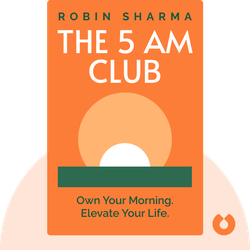Try Blinkist to get the key ideas from 7,000+ bestselling nonfiction titles and podcasts. Listen or read in just 15 minutes.
Start your free trial
Blink 3 of 8 - The 5 AM Club
by Robin Sharma

Free to Learn by Peter Gray is a thought-provoking book that explores the benefits of letting children take control of their own education. It challenges traditional schooling methods and advocates for self-directed learning.
In Free to Learn, Peter Gray, a developmental psychologist, challenges the traditional educational system and advocates for a more natural approach to learning. He begins by exploring the concept of free learning, which is the idea that children learn best when they are free to pursue their own interests and are not constrained by a rigid curriculum or forced to sit in a classroom for hours on end.
Gray argues that the current educational system, with its emphasis on standardized testing and strict curricula, stifles children's natural curiosity and love for learning. He draws on anthropological evidence to show that, historically, children learned through self-directed play and exploration, and that this method of learning is more effective and enjoyable than the traditional classroom model.
One of the key themes in Free to Learn is the importance of play in a child's development. Gray argues that play is not just a way for children to pass the time, but a crucial mechanism for learning. Through play, children develop problem-solving skills, creativity, and social competence. He suggests that by allowing children to play freely, we can help them develop the skills they need to succeed in the real world.
Gray also discusses the negative impact of the decline in free play on children's mental health. He points out that the rise in childhood depression, anxiety, and other mental health issues can be linked to the decrease in unstructured playtime. He argues that by allowing children more freedom to play and explore, we can help them develop the resilience and coping skills they need to navigate life's challenges.
Gray introduces the concept of unschooling, a form of homeschooling that allows children to learn through self-directed exploration and play. He argues that unschooling provides a more natural and effective way for children to learn, as it allows them to pursue their own interests and learn at their own pace. He shares stories of families who have embraced unschooling and highlights the positive outcomes for their children.
Throughout Free to Learn, Gray emphasizes the importance of autonomy in learning. He argues that when children are given the freedom to choose what and how they learn, they become more motivated and engaged in the learning process. He suggests that by giving children more control over their education, we can help them develop a lifelong love for learning.
In the final section of the book, Gray presents a vision for the future of education. He calls for a radical reimagining of the current educational system, one that is based on the principles of free learning. He suggests that schools should provide more opportunities for self-directed learning and play, and that standardized testing should be replaced with more holistic forms of assessment.
Gray's vision for the future of education is one that prioritizes the well-being and autonomy of children. He argues that by embracing free learning, we can create a more joyful and effective educational experience for children, one that prepares them for the challenges of the 21st century. In conclusion, Free to Learn is a thought-provoking exploration of the nature of learning and a compelling argument for a more natural and child-centered approach to education.



Free to Learn by Peter Gray challenges traditional ideas about education and advocates for a more natural approach to learning. Drawing on research and real-life examples, Gray argues that children are naturally curious and learn best when given the freedom to explore and play. He makes a compelling case for rethinking our education system and allowing children to take control of their own learning.
Free to Learn (2012) by Peter Gray explores the importance of play and self-directed learning in children's education. Here's why this book is worth reading:
It's highly addictive to get core insights on personally relevant topics without repetition or triviality. Added to that the apps ability to suggest kindred interests opens up a foundation of knowledge.
Great app. Good selection of book summaries you can read or listen to while commuting. Instead of scrolling through your social media news feed, this is a much better way to spend your spare time in my opinion.
Life changing. The concept of being able to grasp a book's main point in such a short time truly opens multiple opportunities to grow every area of your life at a faster rate.
Great app. Addicting. Perfect for wait times, morning coffee, evening before bed. Extremely well written, thorough, easy to use.
Try Blinkist to get the key ideas from 7,000+ bestselling nonfiction titles and podcasts. Listen or read in just 15 minutes.
Start your free trial
Blink 3 of 8 - The 5 AM Club
by Robin Sharma
What is the main message of Free to Learn?
The main message of Free to Learn is that children learn best when they have freedom and autonomy in their education.
How long does it take to read Free to Learn?
The reading time for Free to Learn varies depending on the reader, but it typically takes several hours. The Blinkist summary can be read in just 15 minutes.
Is Free to Learn a good book? Is it worth reading?
Free to Learn is worth reading for its insights into alternative education methods and the importance of play in children's development.
Who is the author of Free to Learn?
Peter Gray is the author of Free to Learn.